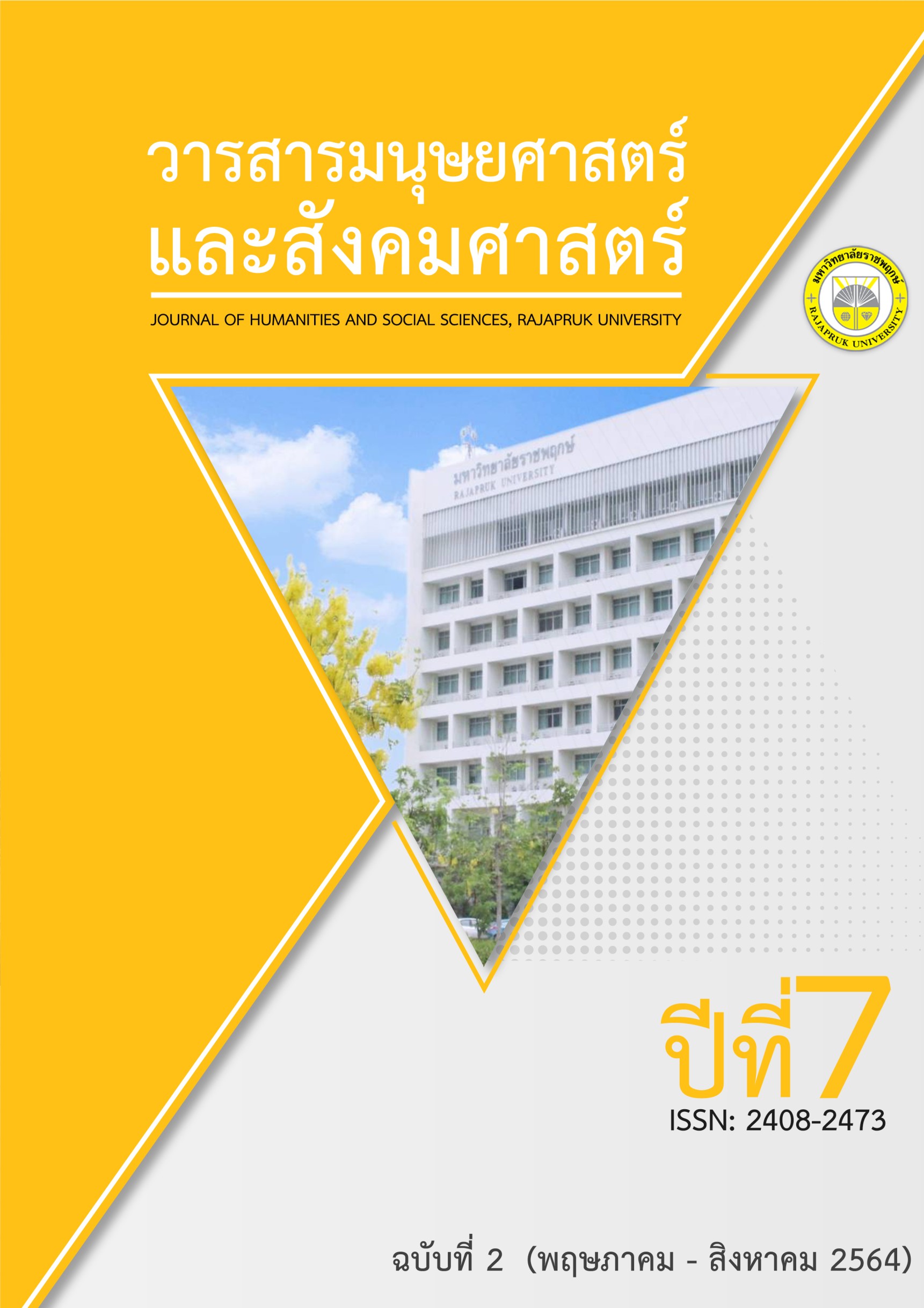Participation in Educational Institutions and Workplaces of Dual Vocational Education Administration in the Colleges under the Vocational Institute of Central Region 1
Main Article Content
Abstract
This research aimed 1) to study the level of participation in educational institutions and workplaces of dual vocational education administration in the colleges under the vocational institute of central region 1, 2) to compare the participation in educational institutions and workplaces of dual vocational education administration classified by personal status, 3) to propose guidelines of participation in educational institutions and workplaces according to the opinions of experts. The sample used in the research consisted of 297 heads of dual vocational education, supervision teachers, teachers and trainers in the workplaces, selected through stratified random sampling and 5 experts selected through purposive sampling. The instruments used questionnaires and interviewing form. The statistics used percentage, mean, standard deviation, t-test, one-way ANOVA, LSD and content analysis. The results of the research were as follows: 1) the level of participation in educational institutions and workplaces of dual vocational education administration in the overall were at a high level ( =4.23, SD=0.51) and all aspects were at a high level, the highest mean was follow-up engagement ( =4.38, SD=0.57), the lower others were measurement and evaluation, operations and coordination, planning and public relations, human resource and curriculum. 2) the comparison of participation in educational institutions and workplaces classified by gender, educational and position were not statistical significantly, except classified by work experience were statistical significantly at .05 level. 3) guidelines of participation in educational institutions and workplaces were should be focused on planning for the students in vocational training, should be a participation in the recruitment and select learners, developed personnel working in dual vocational education and the curriculum development in accordance with the needs of workplaces.
Article Details
References
จงสถาพร ดาวเรือง. (2560). อนาคตภาพการอาชีวศึกษาระบบทวิภาคีของสถานศึกษาสังกัดคณะกรรมการการอาชีวศึกษาในทศวรรษหน้า (พ.ศ.2559-2569). วิทยานิพนธ์ปรัชญาดุษฎีบัณฑิต สาขาวิชาการจัดการเพื่อการพัฒนา มหาวิทยาลัยราชภัฏราชนครินทร์.
ชญานิน สง่าเพ็ชร. (2560). การบริหารงานอาชีวศึกษาระบบทวิภาคี ตามทัศนะของผู้บริหารสถานศึกษาและครูสถาบันการอาชีวศึกษาภาคกลาง 2 สังกัดสำนักงานคณะกรรมการการอาชีวศึกษา. วิทยานิพนธ์ครุศาสตรมหาบัณฑิต สาขาวิชาการบริหารการศึกษา มหาวิทยาลัยราชภัฏเทพสตรี.
ณัฐวิทย์ มุงเมือง. (2560). การพัฒนาความร่วมมือการจัดการอาชีวศึกษาระบบทวิภาคีของวิทยาลัยการอาชีพในภาคเหนือตอนบน. พิฆเนศวร์สาร, 13(1): 133-146.
นิรุตต์ บุตรแสนลี. (2561). การพัฒนารูปแบบการจัดการอาชีวศึกษาระบบทวิภาคีที่มุ่งเน้นประสิทธิผลของสถานศึกษาสังกัดสำนักงานคณะกรรมการการอาชีวศึกษาด้วยกระบวนการวิจัยเชิงปฏิบัติการแบบมีส่วนร่วม. ดุษฎีนิพนธ์ปรัชญาดุษฎีบัณฑิต สาขาวิชาวิจัย วัดผลและสถิติการศึกษา คณะศึกษาศาสตร์ มหาวิทยาลัยบูรพา.
บุญลือ ทองเกตุแก้ว. (2559). รายงานการศึกษาส่วนบุคคลเรื่องการบริหารการจัดการอาชีวศึกษาระบบทวิภาคีของสถานศึกษาในสถาบันการอาชีวศึกษาภาคกลาง 3. สถาบันพัฒนาครู คณาจารย์ และบุคลากรทางการศึกษา สำนักงานปลัดกระทรวงศึกษาธิการ.
ผกามาศ ชัชวาลย์. (2555). ความคิดเห็นต่อผลสัมฤทธิ์การบริหารจัดการศึกษาระดับทวิภาคีสาขาการโรงแรม กรณีศึกษา วิทยาลัยบริหารธุรกิจและการท่องเที่ยวกรุงเทพฯ สำนักงานคณะกรรมการการอาชีวศึกษา กระทรวงศึกษาธิการ. วิทยานิพนธ์รัฐประศาสนศาสตรมหาบัณฑิต สาขารัฐประศาสนศาสตร์ มหาวิทยาลัยราชภัฏพระนคร.
เมตต์ เมตต์การุณ์จิต. (2553). การบริหารจัดการศึกษาแบบมีส่วนร่วม: ประชาชนองค์กรปกครองส่วนท้องถิ่นและราชการ. พิมพ์ครั้งที่ 2. กรุงเทพฯ: ไทยร่มเกล้า.
ยุพาวดี ศิริปีริดิ์. (2559). การจัดการอาชีวศึกษาระบบทวิภาคีในสถานศึกษาสังกัดอาชีวศึกษาจังหวัดอุดรธานี. วิทยานิพนธ์ศึกษาศาสตรมหาบัณฑิต สาขาวิชาการบริหารการศึกษา คณะศึกษาศาสตร์ วิทยาลัยสันตพล.
ศูนย์เทคโนโลยีสารสนเทศและกำลังคนอาชีวศึกษา. (2561). สถิติข้อมูลของนักเรียนนักศึกษาอาชีวศึกษา ประจำปีการศึกษา 2561. ค้นเมื่อวันที่ 9 ธันวาคม 2561, จาก http://techno.vec.go.th
สำนักงานคณะกรรมการการอาชีวศึกษา. (2551). พระราชบัญญัติการอาชีวศึกษา พ.ศ.2551.กรุงเทพฯ: สำนักงานคณะกรรมการการอาชีวศึกษา.
สำนักงานเลขาธิการสภาการศึกษา. (2560). รายงานการติดตามและประเมินผลการจัดการอาชีวศึกษาระบบทวิภาคี. สำนักประเมินผลการจัดการจัดการศึกษา. กรุงเทพฯ: พริกหวานกราฟิก.
อิสรียา ออสุวรรณ. (2559). แนวทางการบริหารสถานศึกษาอาชีวศึกษาเอกชนระบบทวิภาคีในเขตกรุงเทพมหานคร. วิทยานิพนธ์ปริญญาครุศาสตรมหาบัณฑิต สาขาวิชาบริหารการศึกษา คณะครุศาสตร์ จุฬาลงกรณ์มหาวิทยาลัย.
อุดมศักดิ์ มีสุข. (2560). การพัฒนารูปแบบการจัดการอาชีวศึกษาระบบทวิภาคี ในสถานศึกษาสังกัดสถาบันอาชีวศึกษาภาคกลาง. วารสารวิทยาลัยดุสิตธานี, 11(3): 221-235.
Barbel Furstenau, Matthias Pilz & Philipp Gonon. (2014). The Dual System of Vocational Education and Training in Germany: What Can Be Learnt About Education for (Other) Professions. Retrieved 25th January 2020, from https://bit.ly/341NTe8
Krejcie, R. V. & Morgan, D. W. (1970). Determining Sample Size for Research Activities. Educational and Psychological Measurement, 30(3), 607-610.


